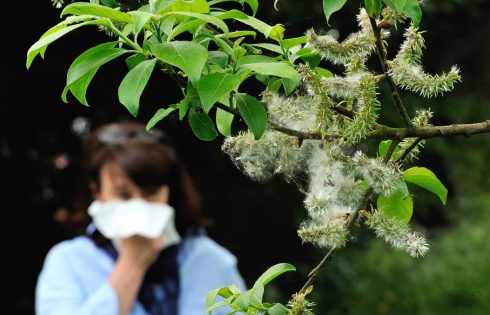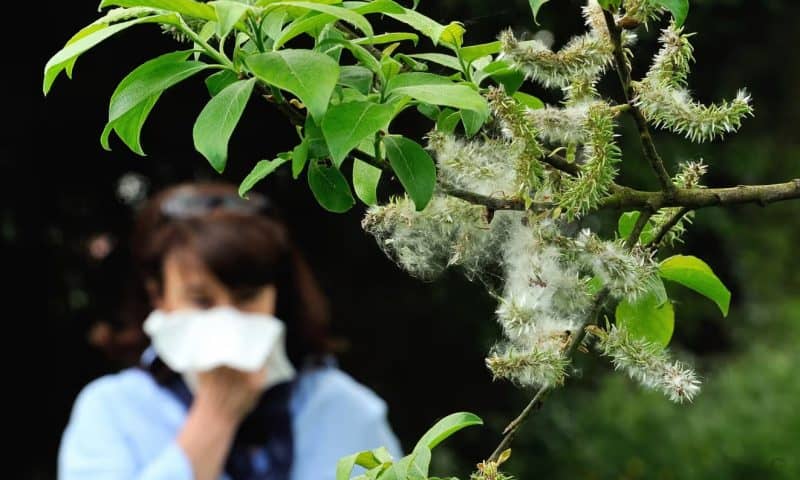
The first time it happened, László Makra thought he had flu. The symptoms appeared from nowhere at the end of summer in 1989: his eyes started streaming, his throat was tight and he could not stop sneezing. Makra was 37 and otherwise fit and healthy, a mid-career climate scientist in Szeged, Hungary. Winter eventually came and he thought little of it. Then, it happened the next year. And the next.
“I had never had these symptoms before. It was high summer: it was impossible to have the flu three consecutive years in a row,” he says.
The following year, a doctor finally tracked down the culprit: common ragweed. Transported to Europe from North America in the 1800s, the invasive species has become widespread in parts of central and eastern Europe. The weed is highly allergenic: a single plant produces millions of tiny grains of airborne pollen and for some asthma sufferers, exposure can be life-threatening. In the US, almost 50 million people are affected by common ragweed each year, extending the allergy season into early November.
After the diagnosis, Makra switched the focus of his research to how rising temperatures impact pollen. Now 73, the University of Szeged professor has become a leading international expert on the subject, co-authoring studies that show the pollen season is becoming longer and more severe in many places around the world as temperatures increase.
While there is a clear rise in the number of people reporting hay fever symptoms each year – part of a global surge in allergies – the reasons behind it are complicated and not yet fully understood.
Pollution, rising temperatures, increasing thunderstorms and the spread of invasive species are all transforming the world of pollen, with consequences that vary from place to place and year to year. In turn, these changes are having complex, varied effects on the human body – with sometimes deadly or debilitating consequences.
Thunderstorm asthma
In November 2016 in Melbourne, emergency departments saw a wave of thousands of admissions after a thunderstorm during peak pollen season, resulting in at least nine deaths and dozens of people in intensive care. More than 8,500 people visited hospitals after the storm, with police and firefighters receiving thousands of calls from people with breathing difficulties. The combination of plunging temperatures, rising humidity and a high pollen count drove the rare weather event, which has also been recorded in London, Birmingham and Naples.
Although rare, thunderstorms are a known trigger for asthma attacks, and hay fever suffers are more likely to be affected. These “asthma epidemics” have only been recorded during pollen and outdoor mould seasons. Exactly how storms trigger the attacks is not clear, but scientists have proposed it is a combination of wind blowing more pollen into the air, and moisture in the atmosphere breaking pollen particles into smaller pieces – so they can penetrate more deeply into airways. As more moisture builds up in the atmosphere due to global heating, thunderstorms are becoming more common and intense.
Pollution
Since the 1960s, scientists say more than 350,000 chemical molecules have been introduced into everyday life, many of which are harmful pollutants. They are interacting with pollen and the human body to make hay fever worse.
First, particulate pollution from cars and industry is interacting with pollen, causing it to produce more allergens. One study of birch pollen in Poland, which affects about a quarter of UK hay fever sufferers, found that pollen in polluted areas had higher levels of a key allergen: Bet v1. The results of this effect are being seen in symptom surveys. A 2023 study by scientists at the University of Manchester found that people living in towns and cities reported significantly more severe hay fever symptoms, indicating a potential relationship with urban pollutants.
Next, researchers theorise that modern chemicals and pollutants are damaging the protective layers in our skin and mucus, making them “leaky” and therefore more exposed to allergens. Known as the “epithelial barrier hypothesis”, experts say this is one of the factors behind the growth in people suffering with pollen allergies as well as sensitivities to food and autoimmune conditions.
Prof Claudia Traidl-Hoffmann at the Institute of Environmental Medicine and Integrative Health, University hospital Augsburg in Germany, says: “Our epithelial cells – that perform as a protective barrier on our skin and organs – are constantly being attacked by chemicals in the modern era: ultra fine particles, carbon particles, volatile organic compounds, chemicals in water, clothing, in our nutrition. They are all acting on our bodies, our gut, our oesophagus. The nearer a child lives to a high-traffic road, the higher the probability a child develops asthma and allergies.”
Contact with animals – particularly cows and dogs – is known to help prevent the development of allergies, Traidl-Hoffmann says, as does a diet varied in plants for young children.
Climate breakdown
In many countries, the hay fever season is starting earlier, lasting longer and producing higher pollen loads – and there are predictions that rising temperatures will cause a major increase in severity over time. One estimate for north-west Europe indicates a 60% future increase.
Changes are already being recorded. A 2019 study found that from Iceland to Canada, several locations in the northern hemisphere are seeing rises in the cumulative pollen released by plants as they benefit from higher CO2 levels and warmer temperatures. In the US, a recent review found a similar trend, with pollen production projected to increase by 16–40% by the end of the century. But this is not occurring everywhere and the changes are complicated and variable, with extreme heat and flooding sometimes decreasing pollen levels. In the UK, only about 30 pollens cause hay fever, with grass pollen the most common. Across Britain, there have been very modest changes in recent years in allergenic pollen, say researchers. Birch pollen levels in central England have risen – with a clear link to climate change – while others have not seen a difference.
Beverley Adams-Groom, a researcher at the University of Worcester who worked with the Met Office on pollen forecasts for 29 years, says: “To a certain extent, pollen levels [in the UK] haven’t changed all that much. Grass pollen, which is one of the most important pollen types for UK hay fever sufferers as it affects about 95% of hay fever sufferers – has not shown any distinct change in the trend since about 2007.”
Some of the worst-offending species are set to benefit from global heating, with the common ragweed season having already extended by 25 days in parts of the US and Canada.
Lewis Ziska, an associate professor in environmental health sciences at Columbia University, says: “We know that of the plants that we associate with allergies, they are moving or migrating northward. So, for example, if you look at common ragweed, which is a progenitor for pollen in the fall, it’s now showing up in places in Norway and Sweden, and other places where it has not been seen previously. The winters are getting milder, and with milder winters, we typically have spring … happening earlier in the year, and then the fall happening later.”
Invasive species
In some parts of Europe, there is growing recognition of the public health risks from invasive species with allergenic pollen. In Switzerland, leaf beetles that eat common ragweed have been introduced from North America to counteract the plant.
But the plant has already infested several regions in Europe, particularly Hungary, the Balkans, southern France and north-west Italy, with an estimated 13.5 million Europeans suffering from allergic reactions to it, resulting in €7.4bn (£6.3bn) worth of health costs a year. With ragweed pollen concentrations projected to quadruple by the middle of the century, this could add more to the economic burden from hay fever.
Researchers say that as the climate changes, so too will the community of plants around the world, with resulting consequences for pollen. But exactly what that will look like is still unclear.
“In environmental medicine, it is never only one factor causing something, but a mixture of metrics. It’s like a mosaic. We have a longer pollen season because of climate change. The pollen are more aggressive because of pollution and rising temperatures. Another factor is new pollen from invasive species,” says Traidl-Hoffmann.
“My message is not to be afraid. Yes, climate change, is impacting on our health, especially allergies. But let’s take this as a chance and a challenge to do things better in the future,” she says.

